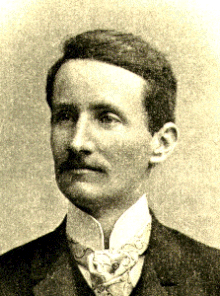Walter Ritz
Walter Ritz (or Walther Ritz , born February 22, 1878 in Sitten , † July 7, 1909 in Göttingen ) was a Swiss mathematician and physicist .
Life
Walter Ritz's father Raphael Ritz was born in Valais and a well-known painter. His mother, born Nördlinger, was the daughter of an engineer from Tübingen . Ritz was a particularly gifted student and attended the municipal lyceum in Sion. In 1897 he entered the polytechnic school in Zurich , where he studied engineering. He soon found out that he couldn't live with the approximations and compromises associated with engineering and so he switched to the mathematically more exact physical sciences.
In 1900 Ritz fell ill with tuberculosis , possibly also with pleurisy ( pleurisy ), from which he would later also die. In 1901 he moved to Göttingen for health reasons. There he was influenced by Woldemar Voigt and David Hilbert . Ritz wrote a dissertation on the spectral lines of atoms and received his doctorate summa cum laude. The topic later led to the Ritz combination principle and in 1913 to the atomic model by Ernest Rutherford and Niels Bohr .
In the spring of 1903 he heard lectures from Hendrik Antoon Lorentz on electrodynamic problems and its new electron theory in Leiden . In June 1903 he was in Bonn at the Heinrich Kayser Institute, where he found a spectral line in Pottasche that he had predicted in his dissertation. In November 1903 he was in Paris at the École Normale Supérieure. There he worked on infrared photographic plates.
In July 1904 his illness worsened and he moved back to Zurich. The disease prevented him from further scientific publications until 1906.
In September 1907 he moved to Tübingen, his mother's place of origin, and in 1908 back to Göttingen, where he became a private lecturer at the university. There he published his work Recherches critiques sur l'Électrodynamique Générale .
As a student, friend or colleague, Ritz had contacts with many contemporary scholars such as Hilbert, Andreas Heinrich Voigt , Hermann Minkowski , Lorentz, Aimé Cotton , Friedrich Paschen , Henri Poincaré and Albert Einstein . He was a fellow student of Einstein's in Zurich, who also studied there.
Ritz died in Göttingen and was buried in the Nordheim cemetery in Zurich . The family grave was lifted on November 15, 1999. His gravestone is on field 17 with grave number 84457.
Scientific achievements
With the Ritz method, Ritz provided a calculation method for technical mechanics and theoretical preliminary work for the finite element method (FEM). The Ritz method is also known as the Ritz method, Ritz's principle of variation and Rayleigh-Ritz's principle.
In 1908 Ritz empirically discovered the Ritz combination principle named after him . According to this, the sum or difference of the frequencies of two spectral lines is often the frequency of another line. Which of these calculated frequencies is actually observed was only later explained by selection rules that follow from quantum mechanical calculations. The basis for this was the spectral line research ( Balmer series ) by Johann Jakob Balmer .
Walter Ritz, like others, represented the emission theory , a "ballistic" theory of light similar to Newton's emission theory, as an alternative to Lorentz's electrodynamics and special relativity theory . Ritz's emission theory dealt with the Galilean transformations of speeds of light, instead of the structure of space and time, as well as the Lorentz transformations of speeds. Ritz discussed it with Einstein and led a scientific dispute with him in the "Physikalische Zeitschrift" in 1908/1909 until his death. The emission theory, however, is considered refuted.
The physical unit Ritz standard is named after Ritz. Ritz worked with Johannes Rydberg on the Rydberg-Ritz formula .
Fonts
- On a New Law of Series Spectra . In: The Astrophysical Journal 28, p. 237 (1908), doi: 10.1086 / 141591
- Theories about ether, gravity, relativity and electrodynamics . Step-Verlag, Bern 1963. (Step series; No. 6)
- About the role of the ether in physics . In: Scientia 1908, No. VI: " Du rôle de l'éther en physique "
- Recherches critiques sur l'Électrodynamique Générale , Annales Chemie et de Physique, 13, 145, 1908
- Collected Works - Oeuvres . Published by the Société Suisse de Physique, Gauthier-Villars, Paris 1911.
literature
- P. Forman: Dictionary of Scientific Biography . Vol. XI. Charles Scribner's Sons, New York 1975, p. 475
- Claus Priesner: Ritz, Walter. In: New German Biography (NDB). Volume 21, Duncker & Humblot, Berlin 2003, ISBN 3-428-11202-4 , p. 673 f. ( Digitized version ).
- Jean-Claude Pont (Ed.) Le Destin Douloureux de Walther Ritz, physicien théoricien de génie , Sion: Archives de l'Etat de Valais, 2012 (= Proceedings of an International Conference in Honor of Walther Ritz's 100th Anniversary)
Web links
- Literature by and about Walter Ritz in the catalog of the German National Library
- Erwin Neuenschwander: Ritz, Walter. In: Historical Lexicon of Switzerland .
- Abbreviated Biographical Sketch of Walter Ritz
- Critical Researches on General Electrodynamics, Walter Ritz, 1908
- The Ritz-Einstein Agreement to Disagree
- Source for the Ritz standard (PDF; 188 kB)
| personal data | |
|---|---|
| SURNAME | Ritz, Walter |
| BRIEF DESCRIPTION | Swiss mathematician and physicist |
| DATE OF BIRTH | February 22, 1878 |
| PLACE OF BIRTH | Sion , Canton of Valais , Switzerland |
| DATE OF DEATH | July 7, 1909 |
| Place of death | Göttingen , Hanover Province , Kingdom of Prussia , German Empire |
